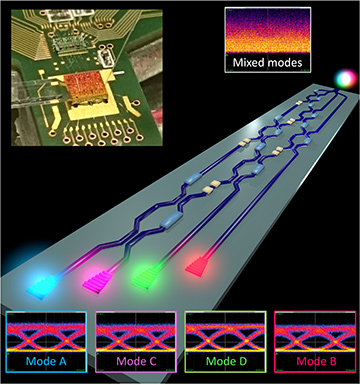 Information encoded in strongly mixed modes (A, B, C, D), sharing the same wavelength and polarization, is recovered by a self-configuring silicon photonics mesh (inset photonic-chip photo), which can automatically reconstruct, separate and sort out the original beams.
Information encoded in strongly mixed modes (A, B, C, D), sharing the same wavelength and polarization, is recovered by a self-configuring silicon photonics mesh (inset photonic-chip photo), which can automatically reconstruct, separate and sort out the original beams.
Light beams can get mixed by transmission through a scattering system like a multimode channel. Separating beams of the same wavelength and polarization would appear to be very hard. Although the information carried by the beams is not fundamentally lost, its recovery requires a coherent interferometric reconstruction of the original signals, which have been scrambled among the modes of the system.
In principle, a reconfigurable mesh of 2×2 interferometers could perform the necessary unitary mathematical operation.1 In practice, however, use of such photonic meshes—the size of which scales up quadratically with the number of modes—has been hindered by the need for complex, time-consuming procedures for calibration, control and configuration. Setting up and stabilizing a complex network of interferometers can be challenging, especially for interferometers buried inside the mesh.
In work this year, we constructed a silicon photonics integrated mesh that can self-configure automatically to unscramble arbitrarily mixed optical beams, without any advance knowledge of the scattering system.2 Our architecture integrates six thermally controlled Mach-Zehnder interferometers that are sequentially and automatically adjusted, without calculations, to simultaneously reconstruct, separate (with a residual crosstalk of less than –20 dB), and sort out four optical beams that have been completely mixed in a multimode waveguide.
By keying each signal with a different pilot tone, built-in transparent detectors3 monitor the evolution of each mode along the mesh, allowing tuning and adaptive individual feedback control of each interferometer with a simple, progressive algorithm.4 The entire mesh, controlled by custom-designed electronics, resets itself automatically after the mode mixing is significantly perturbed, can completely reconfigure on a time scale of a few seconds, and can track modes undergoing time-varying mixing on a time scale of a few hundred milliseconds.
Our calibration and control strategy enables scalability to larger meshes (that is, to higher numbers of modes) without substantially increasing control complexity. Further, the principle of a self-configuring, self-resetting mesh can be extended to different mesh topologies to implement nonunitary linear operations4 and emerging programmable photonic processors,5 for applications in fields such as telecommunications, imaging, sensing, secrecy and quantum information processing. This work demonstrates that, despite the apparent challenges of undoing complicated scattering and interferometric mixing of optical beams, self-configuring and self-stabilizing optics systems can automatically unscramble light in real time.
Researchers
Francesco Morichetti, Andrea Annoni and Andrea Melloni, Politecnico di Milano, Italy
David A.B. Miller, Stanford University, Calif., USA
References
1. M. Reck et al. Phys. Rev. Lett. 73, 58 (1994).
2. A. Annoni et al. Light Sci. Appl. 6, e17110 (2017).
3. F. Morichetti et al. IEEE J. Sel. Top. Quantum Electron. 20, 292 (2014).
4. D.A.B. Miller. Photon. Res. 1, 1 (2013).
5. J. Capmany et al. Nat. Photon. 10, 6 (2015).
